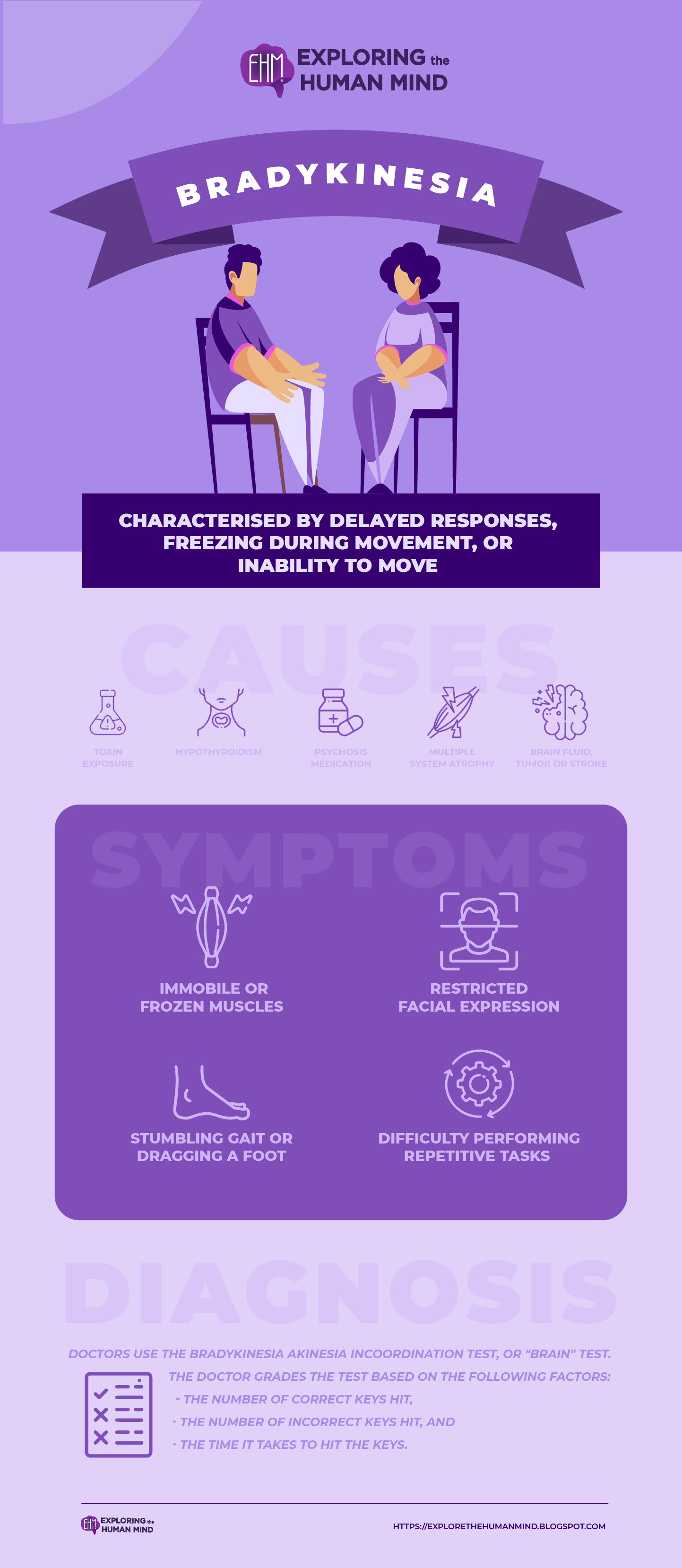Bradykinesia
People frequently use the terms bradykinesia, hypokinesia, and akinesia interchangeably, but they are not interchangeable:
- Hypokinesia means “smallness of movement.”
- Akinesia means “absence of movement.”
- Bradykinesia means “slowness of movement.”
Symptoms
A person with bradykinesia may have
- immobile or frozen muscles in addition to slow movements and reflexes
- restricted facial expression
- a stumbling gait or dragging a foot while walking
- difficulty performing repetitive tasks such as typing difficulty speaking and swallowing
These can have an impact on a person's mobility and ability to perform daily tasks. Bradykinesia patients may experience a "sequence effect," in which their movement patterns change during an activity. For example, a person's steps may become progressively smaller.
Causes
Experts are still unsure why bradykinesia occurs. Changes in nervous system networks that affect movement appear to be the cause.
The basal ganglia and brain structures that connect to it, such as the primary motor cortex and the cerebellum, appear to be involved in this process.
Bradykinesia is associated with several types of Parkinson's disease, including vascular parkinsonism, which is caused by changes in the blood supply to the brain.
Other factors:
- toxin exposure
- hypothyroidism
- medication used to treat psychosis
- multiple system atrophy
- fluid on the brain, or hydrocephalus
- a brain tumor
- stroke
Diagnosis
Doctors use the bradykinesia akinesia incoordination test, or "BRAIN" test, to diagnose bradykinesia. For one minute, the person must perform a series of rapid taps on a keyboard with alternating fingers.
The doctor grades the test based on the following factors:
- the number of correct keys hit
- the number of incorrect keys hit
- the time it takes to hit the keys
The results aid in determining whether or not a person has bradykinesia and how severe it is. It is also used to detect Parkinson's disease.
Treatment
The cause of bradykinesia determines the treatment. If it is a stroke or a brain tumour, the doctor may suggest surgery, medication, or other treatments. Bradykinesia, on the other hand, is most commonly associated with Parkinson's disease. The symptoms of this disease are caused by low dopamine levels in the brain. Increasing the body's dopamine levels is one treatment option.
Bradykinesia can appear in a variety of ways, including difficulty with repetitive tasks such as tapping fingers or clapping hands; a decrease in automatic movements such as blinking the eyes or swinging the arms when walking; and difficulty initiating movements such as standing up or turning in bed. Progressive bradykinesia can cause freezing, which is a pause in movement that occurs when walking and at thresholds (for example, crossing a door frame or entering a lift). Hypomimia, a condition caused by generalised bradykinesia, is the appearance of unnatural stillness or decreased facial expression.

vectors by Freepick; graphic design by Vadot
Reference:
Fletcher, J. (2018). What you should know about bradykinesia. Medicalnewstoday.com; Medical News Today. https://www.medicalnewstoday.com/articles/320487#takeaway
Disorders of the Motor System (Section 3, Chapter 6) Neuroscience Online: An Electronic Textbook for the Neurosciences | Department of Neurobiology and Anatomy - The University of Texas Medical School at Houston. (2020). Tmc.edu. https://nba.uth.tmc.edu/neuroscience/m/s3/chapter06.html
Bradykinesia: What Is It, Causes, Diagnosis, and More | Osmosis. (2020). Osmosis. https://www.osmosis.org/answers/bradykinesia






Comments
Post a Comment